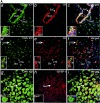Human cytomegalovirus transmission from the uterus to the placenta correlates with the presence of pathogenic bacteria and maternal immunity
- PMID: 14645586
- PMCID: PMC296088
- DOI: 10.1128/jvi.77.24.13301-13314.2003
Human cytomegalovirus transmission from the uterus to the placenta correlates with the presence of pathogenic bacteria and maternal immunity
Abstract
Prenatal cytomegalovirus infection may cause pregnancy complications such as intrauterine growth restriction and birth defects. How virus from the mother traverses the placenta is unknown. PCR analysis of biopsy specimens of the maternal-fetal interface revealed that DNA sequences from cytomegalovirus were commonly found with those of herpes simplex viruses and pathogenic bacteria. Cytomegalovirus DNA and infected cell proteins were found more often in the decidua than in the placenta, suggesting that the uterus functions as a reservoir for infection. In women with low neutralizing titers, cytomegalovirus replicated in diverse decidual cells and placental trophoblasts and capillaries. In women with intermediate to high neutralizing titers, decidual infection was suppressed and the placenta was spared. Overall, cytomegalovirus virions and maternal immunoglobulin G were detected in syncytiotrophoblasts, villus core macrophages, and dendritic cells. These results suggest that the outcome of cytomegalovirus infection depends on the presence of other pathogens and coordinated immune responses to viral replication at the maternal-fetal interface.
Figures










Similar articles
-
Zika Virus Infects Early- and Midgestation Human Maternal Decidual Tissues, Inducing Distinct Innate Tissue Responses in the Maternal-Fetal Interface.J Virol. 2017 Jan 31;91(4):e01905-16. doi: 10.1128/JVI.01905-16. Print 2017 Feb 15. J Virol. 2017. PMID: 27974560 Free PMC article.
-
APOBEC3A Is Upregulated by Human Cytomegalovirus (HCMV) in the Maternal-Fetal Interface, Acting as an Innate Anti-HCMV Effector.J Virol. 2017 Nov 14;91(23):e01296-17. doi: 10.1128/JVI.01296-17. Print 2017 Dec 1. J Virol. 2017. PMID: 28956761 Free PMC article.
-
Maternal antibodies enhance or prevent cytomegalovirus infection in the placenta by neonatal Fc receptor-mediated transcytosis.Am J Pathol. 2006 Apr;168(4):1210-26. doi: 10.2353/ajpath.2006.050482. Am J Pathol. 2006. PMID: 16565496 Free PMC article.
-
Insights into viral transmission at the uterine-placental interface.Trends Microbiol. 2005 Apr;13(4):164-74. doi: 10.1016/j.tim.2005.02.009. Trends Microbiol. 2005. PMID: 15817386 Review.
-
Cytomegalovirus infection in the human placenta: maternal immunity and developmentally regulated receptors on trophoblasts converge.Curr Top Microbiol Immunol. 2008;325:383-95. doi: 10.1007/978-3-540-77349-8_21. Curr Top Microbiol Immunol. 2008. PMID: 18637517 Review.
Cited by
-
Human cytomegalovirus-encoded interleukin-10 homolog inhibits maturation of dendritic cells and alters their functionality.J Virol. 2004 Aug;78(16):8720-31. doi: 10.1128/JVI.78.16.8720-8731.2004. J Virol. 2004. PMID: 15280480 Free PMC article.
-
Transmission of murine cytomegalovirus in breast milk: a model of natural infection in neonates.J Virol. 2011 May;85(10):5115-24. doi: 10.1128/JVI.01934-10. Epub 2011 Mar 2. J Virol. 2011. PMID: 21367905 Free PMC article.
-
Induction of an epithelial integrin alphavbeta6 in human cytomegalovirus-infected endothelial cells leads to activation of transforming growth factor-beta1 and increased collagen production.Am J Pathol. 2008 Apr;172(4):1127-40. doi: 10.2353/ajpath.2008.070448. Epub 2008 Mar 18. Am J Pathol. 2008. PMID: 18349127 Free PMC article.
-
Risks associated with viral infections during pregnancy.J Clin Invest. 2017 May 1;127(5):1591-1599. doi: 10.1172/JCI87490. Epub 2017 May 1. J Clin Invest. 2017. PMID: 28459427 Free PMC article. Review.
-
Recent Approaches and Strategies in the Generation of Anti-human Cytomegalovirus Vaccines.Methods Mol Biol. 2021;2244:403-463. doi: 10.1007/978-1-0716-1111-1_19. Methods Mol Biol. 2021. PMID: 33555597
References
-
- Boppana, S. B., and W. J. Britt. 1995. Antiviral antibody responses and intrauterine transmission after primary maternal cytomegalovirus infection. J. Infect. Dis. 171:1115-1121. - PubMed
-
- Boppana, S. B., K. B. Fowler, W. J. Britt, S. Stagno, and R. F. Pass. 1999. Symptomatic congenital cytomegalovirus infection in infants born to mothers with preexisting immunity to cytomegalovirus. Pediatrics 104:55-60. - PubMed
-
- Cella, M., A. Engering, V. Pinet, J. Pieters, and A. Lanzavecchia. 1997. Inflammatory stimuli induce accumulation of MHC Class II complexes on dendritic cells. Nature 388:782-787. - PubMed
-
- Chou, S. W., and K. M. Dennison. 1991. Analysis of interstrain variation in cytomegalovirus glycoprotein B sequences encoding neutralization-related epitopes. J. Infect. Dis. 163:1229-1234. - PubMed
-
- Collier, A. C., H. H. Handsfield, R. Ashley, P. L. Roberts, T. DeRouen, J. D. Meyers, and L. Corey. 1995. Cervical but not urinary excretion of cytomegalovirus is related to sexual activity and contraceptive practices in sexually active women. J. Infect. Dis. 171:33-38. - PubMed
Publication types
MeSH terms
Grants and funding
LinkOut - more resources
Full Text Sources
Other Literature Sources
Medical

